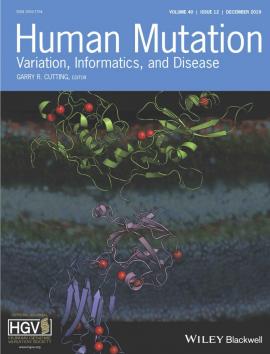Genomic Insight into Clinical Therapy
Dec 4 2019
Posted In:
20/20 Blog
Palo Alto, CA — Research from the Mahajan lab was featured on the cover of Human Mutation'sDecember 2019 issue, highlighting their manuscript, “CAPN5 genetic inactivation phenotype supports therapeutic inhibition trials.”

In 2012 Vinit Mahajan M.D., Ph.D., Associate professor of ophthalmology at Stanford University, identified the CAPN5gene as the cause of ADNIV, a blinding inherited autoimmune, inflammatory eye disease. His research team later found that genetic mutations in CAPN5 lead to enzyme hyperactivity.
This finding was the inpetus for their current work investigating therapies that can inhibit CAPN5 enzyme activity, but an important question all drug designers face is whether inhibiting the enzyme might itself cause serious side-effects. CAPN5 is expressed in the eye but also in many other tissues, including the brain and gut.
Mahajan said, “Turning off an essential gene with a drug could cause its own set of problems. We needed to know if lower than normal CAPN5 enzyme activity might be harmful in and outside the eye.”
Mahajan's research team, in collaboration with Stephen Tsang MD., Ph.D. at Columbia University and Alexander Bassuk M.D., Ph.D. at the University of Iowa, used genetic methods to create a transgenic mouse with complete and partial “knock-out” of the CAPN5 gene. They performed clinical, histological, and molecular analyses and found that the transgenic mice displayed none of the ADNIV disease phenotypes. They were healthy.
Katherine Wert Ph.D., a former postdoctoral fellow in the lab said, “The mice didn’t get sick, develop an eye disease, or die at an early age, demonstrating that low CAPN5 activity is not harmful. It shows that CAPN5 is not essential for normal development and function in mice.”
Dr. Bassuk noted, “The only way to test if a gene is essential is to remove it by genetic engineering. We can do this in mice, but that cannot be done in humans, of course.”
The research team found they did not need to create a human model, because the human genome databases, where nearly 100,000 people worldwide have had their DNA sequenced, provided the model for them.
Mahajan said, “It turns out that there was a hand full of normal patients that had CAPN5 loss of function mutations, meaning their calpain 5 activity was low or zero.”
This indicates that a drug that inhibits or eliminates CAPN5 would be unlikely to have any side effects due to the loss of CAPN5. Essentially, they found naturally occurring human mutations that mirror the results of their mouse genetic modeling.
Mahajan added, “This is a hidden gem in the human genome databases. This bioinformatic approach can be applied widely to other diseases where scientists are designing an inhibitory drug. Mouse models are never perfect, and insight directly in humans is incredibly valuable.”
“CAPN5 genetic inactivation phenotype supports therapeutic inhibition trials” was published in Human Mutation, December 2019.
Authors: Katherine J. Wert, Susanne F. Koch, Gabriel Velez, Chun-Wei Hsu, MaryAnn Mahajan, Alexander G. Bassuk, Stephen H. Tsang, Vinit B. Mahajan.



